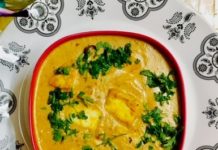
During the months of Ramadan most Muslim dominated cities come to life after sundown. Iftar is shared amidst friend and family. With the call to evening prayers heralded off the minarets of mosques, eateries and homes start getting busy with preparation for iftar or the evening meal. Traditionally the day long fast is broken with 3 dates in the image of the prophet Mohammed, however subsequently it’s a feast of various forms of sweets savories and other food. Spicy kebabs, biriyanis, sweets like jalebis and fruit platters vie attention from the devout breaking their fast and partaking food for the first time since the pre-dawn meal or Seheri. One of the foods that is flavored in the Indian sub-continent during this time is the haleem. Haleem is a traditional Muslim food that is had as a snack food in the streets of Pakistan and India, but also during the month of Ramadan.
Haleem is a traditional Muslim food cooked as a stew made out of mutton and lentils along with wheat and even barley. It was traditionally slow cooked over wooden fires. The month of Ramadan sees haleem prepared in Hyderabad being couriered across the world through special couriers. Pakistanis however enjoy haleem round the year as a snack.
Haleem can trace its origins back to the Arab dish Harees or Harisa from around the 10th century. In fact the Kitab Al-Tabikh or Book of recipes that recorded the culinary choices of the caliph of Baghdad and recorded by Abu Muhammad al-Muzaffar ibn Sayyar has a mention of this stew. The Arab soldiers of the Hyderabad Nizam’s armies brought with them this food of the marching armies and introduced it to the Indian subcontinent. It then spread to the other parts of the subcontinent. This dish is now as popular in the lanes of Hyderabad, Lahore and Dhaka. In Pakistan this has further evolved into the khichra, where instead of a paste like consistency cubed forms of the mutton is also found. Bangladesh also has its own variants. It is also known as the keşkek in parts of Turkey, Iran, Azerbaijan and parts of Iraq, and its original name of Harissa in parts of Armenia.
This food was favored by the armies or traditionally during the months of fasting due to its high nutritive value. Being made out of meat and pulses the food gave high protein content. This enabled the person eating it to survive long hours without hunger pangs, while being nourishing in itself. Also the high wheat content allowed a substantial amount of calories to survive the day. This made it a favored food for the marching armies.
To begin cooking this lip smacking delicacy we need a right combination of various lentils and wheat along with the mutton. To make a portion to serve 3 – 4 people we need the following:
- ½ kg mutton boneless
- 2 tablespoon ginger garlic paste
- 2 onions
- 3 tablespoon red chilli powder
- 2 tablespoon salt
- 2 tea spin cumin powder
- 1 teaspoon turmeric
- 1 table spoon coriander powder
- 1 table spoon Garam masala
- ½ teaspoon nutmeg powder
- ½ teaspoon mace powder
- Oil
- 1 cup wheat
- ½ cup chana (chickpea)
- ¼ cup moong dal (split mung beans)
- ¼ cup masoor dal (split red lentils)
- ¼ cup arhar dal (black gram)
- ¼ cup chopped coriander leaves
The cooking of this dish was traditionally made in large cauldrons on wood fires, however the dish we are cooking is more suited for a smaller serve and our modern kitchens. As in the traditional dish preparation plays a very important role even in the dish that we have modified to suit today’s kitchen. In preparation, appropriate quantities of the lentils mentioned as above are soaked in water overnight and then boiled. These boiled lentils are then set aside for later use. The wheat is also boiled and set aside. Coriander leaves are chopped and set aside for garnishing later. Similarly the onions are also sliced and fried and set aside for garnishing.
To begin cooking the mutton is thoroughly washed. Now pressure cook the mutton using 2 table spoons of oil along with ginger garlic paste, turmeric powder, cumin powder, coriander powder. Add 2 cups of water and cook till the meat becomes tender. Let it cool. Once cooled, shred the mutton and keep aside.
Now blend all the boiled lentils along with the wheat in a blender, till it reaches an even consistency. Now add this blend to the shredded mutton already set aside. Add water to this and mix till it reaches a thick but even consistency, and bring the mix to boil. To this mix now add the mace powder and nutmeg powder and mix well. Remove from the heat and transfer to a serving bowl. Garnish with the coriander leaves and fried onions. Serve with hot Paranthas.
But before we get busy do remember my mother’s special ingredient to make this dish transcend to a higher level. Ramadan is the month of introspection, of greater devotion, so when cooking a meal for this auspicious time it is only right to mix in devotion in the cooking, and what greater devotion then love, what greater prayer than one made with a smile in gratitude of the benevolence of the all merciful One. So add in your love for the ones you cook for and the Creator who gives you His mercy, and mix it with a smile and prayer as you cook. Bon appétit.






